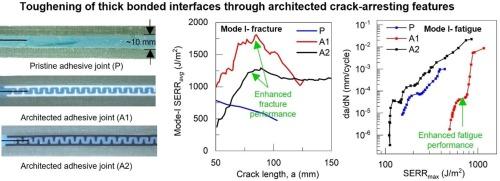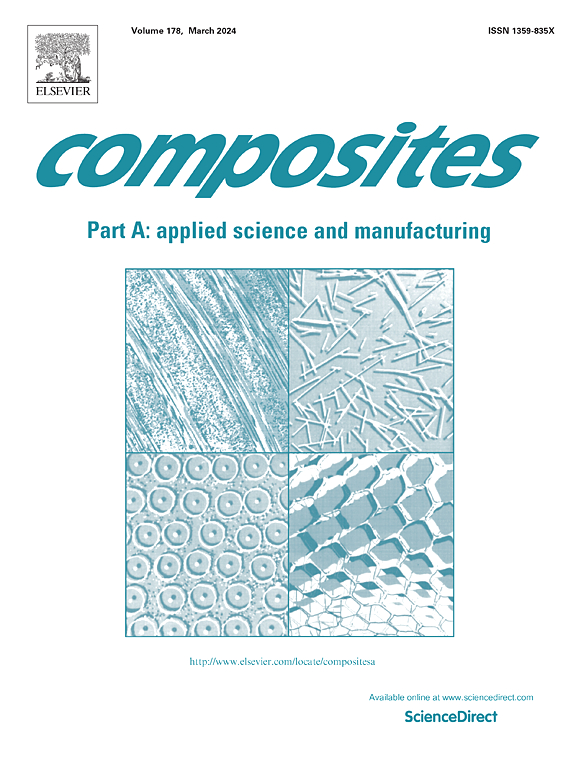通过结构化的抗裂功能实现厚粘接界面的钢化
IF 8.1
2区 材料科学
Q1 ENGINEERING, MANUFACTURING
Composites Part A: Applied Science and Manufacturing
Pub Date : 2024-11-02
DOI:10.1016/j.compositesa.2024.108575
引用次数: 0
摘要
本研究调查了添加式制造的抗裂特征(CAF)在提高风力涡轮机转子叶片中的厚玻璃纤维增强聚合物复合环氧胶粘剂接头性能中的应用,这些抗裂特征由坚韧和柔软的聚合物设计而成。通过双悬臂梁实验评估了这些接头的 I 型断裂和疲劳行为,并与原始接头进行了比较。在原始接头中,裂纹始终偏离粘合剂粘合线进入复合材料粘合剂,导致应变能释放率突然增加。基于线性弹性断裂力学的有限元模型可帮助我们深入了解这种行为。实验结果表明,采用结构化 CAF 的接头可实现更高的应变能释放率、更稳定的破坏机制,并最大限度地减少对复合材料粘合剂的损坏。在疲劳载荷下,与原始接头和使用软 CAF 材料的接头相比,使用坚韧 CAF 材料的接头的疲劳裂纹增长速度更慢。本文章由计算机程序翻译,如有差异,请以英文原文为准。

Toughening of thick bonded interfaces through architected crack-arresting features
This research investigates the application of additively manufactured crack-arresting features (CAFs), designed from tough and soft polymers, in enhancing the performance of thick glass fiber-reinforced polymer composite-epoxy adhesive joints found in wind turbine rotor blades. Mode I fracture and fatigue behaviors of these joints are assessed through double-cantilever beam experiments and compared against pristine joints. In pristine joints, cracks consistently deviate from the adhesive bondline into the composite adherend, causing a sudden increase in strain energy release rate. Finite element models based on linear elastic fracture mechanics are employed to provide insight into this behavior. Experimental results demonstrate that joints with architected CAFs achieved higher strain energy release rates, more stable failure mechanisms, and minimized damage to the composite adherend. Under fatigue loading, joints featuring tough CAF material exhibit slower fatigue crack growth compared to both pristine joints and those with soft CAF material.
求助全文
通过发布文献求助,成功后即可免费获取论文全文。
去求助
来源期刊

Composites Part A: Applied Science and Manufacturing
工程技术-材料科学:复合
CiteScore
15.20
自引率
5.70%
发文量
492
审稿时长
30 days
期刊介绍:
Composites Part A: Applied Science and Manufacturing is a comprehensive journal that publishes original research papers, review articles, case studies, short communications, and letters covering various aspects of composite materials science and technology. This includes fibrous and particulate reinforcements in polymeric, metallic, and ceramic matrices, as well as 'natural' composites like wood and biological materials. The journal addresses topics such as properties, design, and manufacture of reinforcing fibers and particles, novel architectures and concepts, multifunctional composites, advancements in fabrication and processing, manufacturing science, process modeling, experimental mechanics, microstructural characterization, interfaces, prediction and measurement of mechanical, physical, and chemical behavior, and performance in service. Additionally, articles on economic and commercial aspects, design, and case studies are welcomed. All submissions undergo rigorous peer review to ensure they contribute significantly and innovatively, maintaining high standards for content and presentation. The editorial team aims to expedite the review process for prompt publication.
 求助内容:
求助内容: 应助结果提醒方式:
应助结果提醒方式:


